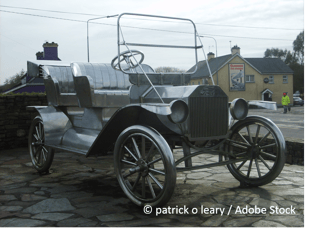This third stage of digital transformation — in our series that outlines the Six Stages of Digital Transformation for CMOs and other marketing professionals — focuses on the Sense of Urgency that starts to bubble up and build across an organization.
According to the Altimeter Group, companies go through six stages on the path to digital transformation, with the sixth stage being “Innovative and Adaptive”. Keep in mind that the path to digital transformation is a journey, not a destination. The sixth stage is not a final stage so much as a new state where a company is more nimble, agile and ready to change in reaction to changing customer needs — a company prepared for the present and for the future!
The stage that we’ll cover today, “Sense of Urgency” is the third stage. In this third stage, we see momentum start to build, company-wide, as the importance to shift focus to that of the all-important customer journey is grasped.
The Sense of Urgency Felt by Change Agents Accelerates Change
This is the stage where change agents get their hands dirty. This stage demands that change agents reach across established company barriers to break down theestablished silos. Soon, the days of individual contributors and entire departments doing their jobs without regard to others, without considering how their roles relate to the overall customer journey, will be a thing of the past.
This growing sense of urgency, first experienced by change agents — and now perceived by many more across the company — who sense that there’s a need to modernize the customer experience. This growing sense is due to many factors that includes, but is not limited to:
- Results from customer feedback
- Results from prospect feedback
- Lagging sales
- Loss of market share
- Success of competitors
- Innovative new competitors in the same niche
- The overall perception that the company is falling behind the technological curve
Change Agents – The Forces that Undermine the Status Quo
 Change agents are the superheros of digital transformation. They face the giant that everyone else is afraid to slay. They are the brave souls who are sticking their necks out, initiating ideas, and pushing theenvelope to get portions of an organization to see the opportunities that are being missed, taking a closer look at the customer journey, and sourcing the technology that will answer that call. They are the risk takers, the decision-makers, the trend-spotters. They are not satisfied. They see the opportunity costs associated with waiting — likely before many of the others in the rest of the organization. They can also identify the changes that need to take place to capitalize on these opportunities. They are the leaders in an organization, regardless of title. Leadership in a modern organization requires working as a change agent.
Change agents are the superheros of digital transformation. They face the giant that everyone else is afraid to slay. They are the brave souls who are sticking their necks out, initiating ideas, and pushing theenvelope to get portions of an organization to see the opportunities that are being missed, taking a closer look at the customer journey, and sourcing the technology that will answer that call. They are the risk takers, the decision-makers, the trend-spotters. They are not satisfied. They see the opportunity costs associated with waiting — likely before many of the others in the rest of the organization. They can also identify the changes that need to take place to capitalize on these opportunities. They are the leaders in an organization, regardless of title. Leadership in a modern organization requires working as a change agent.
“Soon, the days of individual contributors and entire departments doing their jobs without regard to others, without considering how their roles relate to the overall customer journey will be a thing of the past.”
Change agents take on the responsibility of pushing ordinary workers and management to accept the new initiatives that need to take place in order to claim that rightful position, now owned, but that may soon be uppended by a company that can better cater to those at various stages in the buyer’s journey.
They lead in their area of the company, collaborating with others and each other to introduce changes. They set priorities to use technologies to change various departments, and they set the stage for a more unified transformation. Change agents, whatever their formal job titles and functions, are the exception; companies are wise to listen to them if they wish to thrive in the economy of the future.
Facing Digital Darwinism
“Digital Darwinism is a fate that threatens most organizations in almost every industry. Because of this, businesses not only have to compete for today but also for the unforeseeable future. Digital Darwinism is the phenomenon when technology and society evolve faster than an organization can adapt.” – Brian Solis
Change has always been inevitable, but in past eras it happened slowly enough that companies had decades to react to it. Change in customer behavior causes a change in the customer journey, or the influx of new customers, over a longer time period. The railroad industry provides an outstanding example of this. They failed to recognize how cars, long-haul trucks and the national highway system would reduce them to a tiny transportation niche. IBM, another more modern example, fared better. Even so, it went from being the top high-tech company in the world when it sold its mainframe computers — to its current status as a successful, but hardly dominant, technology company.
And although technology is the vehicle for keeping in close connection with a company’s customer base, do keep in mind that digital transformation is not all about technology. The customer journey is the impetus for digital transformation, and it is happening at such a rapid pace. Never has there been a time or such a great opportunity to meet customers where they are with contextually valuable content in order to take advantage of every point possible along the customer journey. In summary, when companies do not take the time to learn what their customers want and how they can BE in the places that their customers are — to provide them with the content that they’re asking for — they risk survival and growth by losing potential sales, market share and reputation.
What Are Your Customers Asking For?
We’re all familiar with the famous quote that was erroneously attributed to Henry Ford, “If I had asked people what they wa nted, they would have said faster horses.” Although these were not his words, they accurately portrayed his sentiments when it came to paying close attention to the customer experience. Unfortunately for Ford, this disregard led to tremendous loss in market share and internal strife and left Ford Motor Company subject to changes in the market’s tastes and competitive innovation.
nted, they would have said faster horses.” Although these were not his words, they accurately portrayed his sentiments when it came to paying close attention to the customer experience. Unfortunately for Ford, this disregard led to tremendous loss in market share and internal strife and left Ford Motor Company subject to changes in the market’s tastes and competitive innovation.
Fortunately, in today’s auto industry, we see people like customer experience execution and planner, David Mingle, of General Motors, following the path of digital transformation.
“We’re creating a mindset around listening to customers and reacting, it’s been transformational. We often find things that look small but, once unraveled, are big opportunities for us,” said Mingle.
This quote exemplifies the potential of digital transformation.The customer is the most important facet of every business; the revenue gained by one change in the customer experience varies, and is difficult to quantify. The wholehearted pursuit toward the heart of the customer journey is well worth the temporary, uncomfortable aspects associated with change.
There’s more to come! Please stay tuned for stages four, five and six along the journey of digital transformation.







